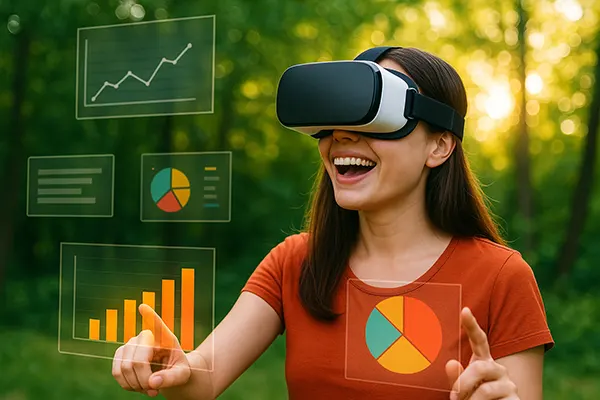
Tactile Reality: A New Era of VR with Sensory Feedback
Virtual reality has already redefined how we experience games, education, and healthcare. Yet the next major leap is no longer just about visuals or spatial audio — it’s about touch. Tactile or haptic feedback is emerging as a pivotal component of immersive digital interaction, bringing the virtual world closer to reality than ever before. As of February 2025, this field is actively evolving, offering new use cases and technical breakthroughs across industries.
Haptic Gloves: Beyond Hand Tracking
Unlike early VR gear that only tracked movement, modern haptic gloves provide realistic touch sensations. These gloves simulate texture, pressure, and even temperature, enabling the user to “feel” virtual surfaces. Companies like HaptX and TeslaSuit have developed gloves that use microfluidic actuators and electrostimulation to recreate tactile sensations in real time.
HaptX’s G1 model, released in late 2024, introduced significant upgrades in pressure sensitivity and latency reduction. It can simulate over 130 points of tactile feedback per hand. Meanwhile, TeslaSuit’s gloves integrate seamlessly with its full-body suit, enabling a consistent sensation across all limbs. These gloves also monitor biometric data, which is vital for both training and therapeutic environments.
While still costly, the technological advancement is undeniable. In professional training, such gloves help trainees develop muscle memory and practice motor tasks with more realism than ever. For example, assembly line workers can now rehearse complex procedures in a safe, repeatable environment with haptic reinforcement.
Market Growth and Integration Potential
The global market for haptic technology in VR is projected to exceed $6 billion by 2027. This rapid growth is driven by its application in gaming, robotics, and training simulations. As of early 2025, several hardware manufacturers have initiated SDK integrations for developers to incorporate tactile feedback into their VR projects.
Meta and Sony are also investing in experimental glove prototypes aimed at the consumer segment, while industrial applications continue to dominate demand. Developers now treat haptics not as an optional feature but as a fundamental element of immersion.
As patents increase and standards are formalised, it’s expected that haptic modules will soon be as common as headsets and controllers. Open-source initiatives like HaptX SDK 3.0 are accelerating adoption, creating an ecosystem where touch becomes central to virtual experiences.
VR in Surgical Training: Precision Without Risk
One of the most promising applications of tactile VR lies in medical education. With tactile feedback, surgeons in training can now simulate operations with real-time response from virtual tissues and instruments. These simulations replicate the resistance and feedback of different organs, enabling students to refine techniques before ever entering an operating theatre.
In February 2025, Johns Hopkins University began using HaptX-integrated VR for laparoscopic surgery training. This solution helps interns navigate delicate procedures such as gallbladder removal or hernia repair. The feedback mimics skin puncture, organ resistance, and even instrument vibration.
Research indicates that haptics-enhanced training can reduce surgical errors by up to 27%. Trainees who engage in regular VR simulations display better tactile decision-making and procedural fluency. These systems are not just visual guides but real-time physiological trainers.
Remote Mentoring and Assessments
Beyond solo practice, VR with haptics enables remote mentorship. A senior surgeon can feel the student’s actions through mirrored gloves and provide live guidance. This capability has transformed global medical training by making expert feedback accessible without the need for travel.
Such simulations also allow real-time assessments. Instructors can evaluate grip strength, instrument handling, and procedural flow based on sensor feedback. All data are recorded, allowing post-session review and iterative improvement.
As telemedicine evolves, this tactile technology could also assist in real-time consultations, allowing specialists to guide physical procedures remotely, a concept that seemed far-fetched only a decade ago.

Artificial Intelligence and Deep Simulation
When combined with AI, tactile VR becomes more adaptive and context-aware. AI algorithms analyse user interaction patterns, personalising force feedback based on previous sessions or user-specific needs. This results in simulations that not only respond accurately but also adjust over time for better engagement and realism.
For instance, an AI-driven surgical simulation can introduce unexpected complications to test a student’s reaction. Likewise, in industrial training, it can dynamically modify the weight or resistance of objects to simulate different real-world conditions.
In February 2025, Unity and NVIDIA announced a partnership to support AI-powered tactile environments with real-time physics. These environments can respond to dozens of sensory inputs while synchronising visual, auditory, and haptic stimuli for a unified experience.
The Road Ahead for Fully Adaptive VR
Developers are working towards full-body haptic suits enhanced by AI models capable of mapping human anatomical responses. These suits are being tested in high-stakes training, including aviation and emergency response drills.
AI also enables personalised rehabilitation programmes, where feedback is calibrated to the user’s recovery stage. By February 2025, start-ups in Germany and Japan are piloting such systems in physiotherapy clinics with promising early results.
The next frontier involves multimodal simulations — synchronised touch, temperature, resistance, and motion — dynamically driven by AI. This convergence marks the beginning of what experts now call “adaptive embodied learning.”
